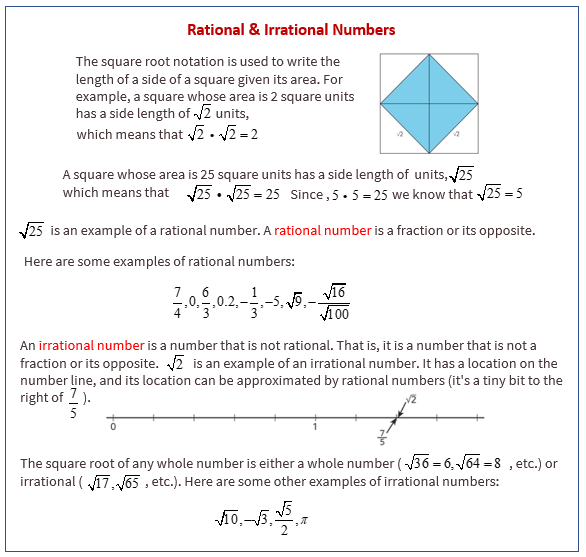Illustrative Mathematics Grade 8, Unit 8, Lesson 3: Rational and Irrational Numbers
Learning Targets:
- I know what a rational number is and can give an example.
- I know what an irrational number is and can give an example.
Related Pages
Illustrative Math
Grade 8
Lesson 3: Rational and Irrational Numbers
Let’s learn about irrational numbers.
Illustrative Math Unit 8.8, Lesson 3 (printable worksheets)
Lesson 3 Summary
The following diagrams explain and give examples of rational and irrational numbers.

Lesson 3.1 Algebra Talk: Positive Solutions
Find a positive solution to each equation:
Lesson 3.2 Three Squares
- Draw 3 squares of different sizes with vertices aligned to the vertices of the grid.
- For each square:
a. Label the area.
b. Label the side length.
c. Write an equation that shows the relationship between the side length and the area.
Lesson 3.3 Looking for a Solution
Are any of these numbers a solution to the equation x2 = 2? Explain your reasoning.
Lesson 3.4 Looking for √2
A rational number is a fraction or its opposite (or any number equivalent to a fraction or its opposite).
- Find some more rational numbers that are close to √2.
- Can you find a rational number that is exactly √2?
Are you ready for more?
If you have an older calculator evaluate the expression (577/408)2 and it will tell you that the answer is 2, which might lead you to think that √2 = 577/488.
- Explain why you might be suspicious of the calculator’s result.
- Find an explanation for why 4082 · 2 could not possibly equal 5772. How does this show that (577/408)2 could not equal 2?
- Repeat these questions for (1414213562375/10000000000000)2 ≠ 2, an equation that even many modern calculators and computers will get wrong.
Lesson 3 Practice Problems
- Decide whether each number in this list is rational or irrational.
- Which value is an exact solution of the equation m2 = 14?
- A square has vertices (0,0), (5,2), (3,7), and (-2,5). Which of these statements is true?
- Rewrite each expression in an equivalent form that uses a single exponent.
- The graph represents the area of arctic sea ice in square kilometers as a function of the day of the year in 2016.
a. Give an approximate interval of days when the area of arctic sea ice was decreasing.
b. On which days was the area of arctic sea ice 12 million square kilometers? - The high school is hosting an event for seniors but will also allow some juniors to attend. The principal approved the event for 200 students and decided the number of juniors should be 25% of the number of seniors. How many juniors will be allowed to attend? If you get stuck, try writing two equations that each represent the number of juniors and seniors at the event.
The Open Up Resources math curriculum is free to download from the Open Up Resources website and is also available from Illustrative Mathematics.
Try the free Mathway calculator and
problem solver below to practice various math topics. Try the given examples, or type in your own
problem and check your answer with the step-by-step explanations.

We welcome your feedback, comments and questions about this site or page. Please submit your feedback or enquiries via our Feedback page.